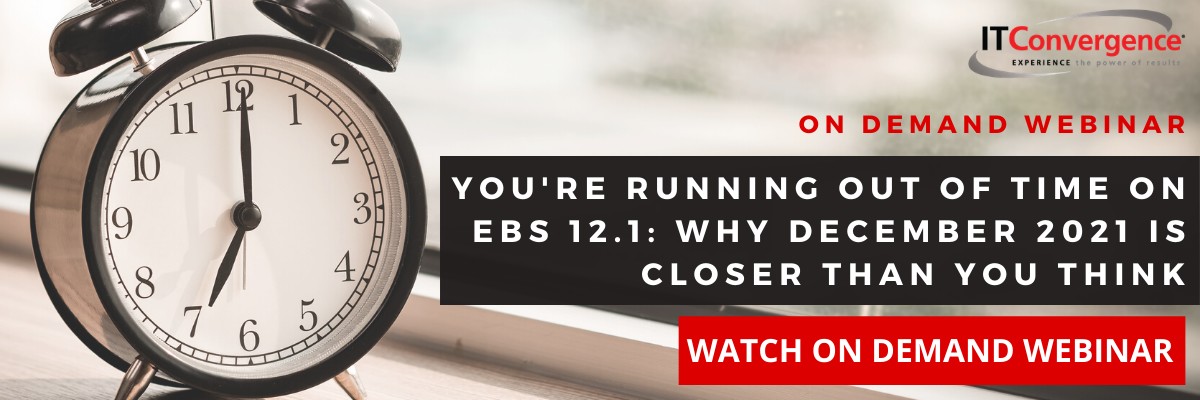Last Thursday Nov 7th, we had our webinar: “You’re running out of time on EBS 12.1”, as promised we are bringing you the transcript of the questions made on that session.
Q: Is there a recent Gartner Magic Quadrant for Oracle Service Providers?
A: Gartner stopped that particular Magic Quadrant for Oracle Applications On-Prem. There’s a new Magic Quadrant that focuses on just Oracle Cloud Services worldwide and IT Convergence is also a part of that Magic Quadrant.
Q: What is the typical duration of an Oracle ERP Cloud implementation? I heard its a few months only.
A: Those are typically shorter than an EBS implementation. The primary reason for this is that when implementing EBS you would typically start from the business requirements, figure where the gaps are with EBS and then often create CEMLIs to fill those gaps. With Cloud implementations the focus goes the other way. You start with the application capabilities and then look out towards the business requirements. Where there is a gap, you tend to ask “Why not adopt best practices” as provided in the application and not create a CEMLI. ERP Cloud implementation is less of a focus on creating CEMLIs and more of a focus on data conversion, retraining and change management, which makes the duration shorter as your question indicated. This doesn’t mean you can’t build CEMLIs in Cloud ERP, but there’s less focus on it, so implementations tend to be a lot shorter and different from EBS implementations.
Q: What are the tech stack changes in 12.2? In general, how do they impact the CEMLI?
A: There are a lot of technical changes in 12.2. There are some that happen at the database level and others at the application server level (which got changed to Weblogic). The tech stack changes that people are most familiar with or aware of are at the underlying database layer and are required to enable hot patching or online patching. An example of what this means is that objects in the database are now “versioned” to enable hot patching. When you start applying a patch a table in the database is on version N, while at the end of the patch the table is on version N+1, with the new version reflecting any schema changes. When we talk about remediating CEMLI, it means (for one thing) that you need to write your CEMLI code in such a way that it understands that object versioning is going on in the underlying database that the CEMLI is accessing, and you need to make sure the code can operate correctly in that environment. Object versioning in the database is the biggest thing that gets a lot of attention by being forced upon customers in 12.2, but there are other tech stack changes that can impact things. ITC has a series of scripts, as does Oracle, that we run together to analyze all of your CEMLI code to point out which CEMLI are going to be affected by the changes.
Q: From a user and change management perspective, what is the 12.1 to 12.2 functional experience like? How about 12.1 to Cloud SaaS?
A: If you did a pure technical upgrade and didn’t take advantage of the new features in 12.2, then you can minimize your change management problem to a great extent. From a business process standpoint, you do have the opportunity in 12.2 in a lot of places to use a new user interface that looks a lot like the cloud user interface. It is more modern user interface, built with a new Oracle Application environment that has a mobile-first point of view. You’ll find your younger users (or millennials) probably adapt better to it. On the other hand, you’ll find older users that have been using Oracle Forms for many years, have some resistance to the new interface, but it is something that can be overcome. It is a much nicer user interface and provides more capabilities and features, especially in areas like Mobility, and it is really similar to that employed in Oracle Cloud SaaS, so the same kind of change management engagement would be required.
Q: What does support end means for customer who is running Oracle Payroll? Does it mean they will NOT receive regular patches?
A: Short answer is that you wouldn’t get regular patches. We’ve seen customers that work out some deals with Oracle to get support by paying extra fees, but that’s a really not a good situation to be in.
Q: Since R12.2.x sits on top of Weblogic, and R12.1.3 is built on IAS, do I need new licenses when upgrading to R12.2.x for Weblogic?
A: If you are just using the application server for EBS only, you are not going to need to buy any additional licenses. It’s a like for like upgrade. If on the other hand, you’ve built your own custom applications and they are using IAS, you would need to redo them to use Weblogic and there will certainly be some licensing implications for that.
Q: If I want to do a Chart of Accounts (CoA) redesign, how can I do that in EBS?
A: There are two ways to do it. You can always reimplement and change the CoA, which has certainly been a long-accepted but painful process. The other way is with a third-party tool that is certified to make the changes, supplied by a company ITC has partnered with many times. It is a very solid solution and relatively painless to implement. If you would be interested in doing this as a part of your technology roadmap, we would be happy to talk with you about it and work with this company to get it done for you. Thank you to all people who attended to our webinar, if you want to see the recording or access the presentation deck click on the image below. 
